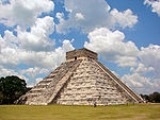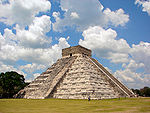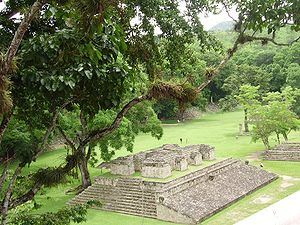
Jungle tourism
Encyclopedia
Jungle tourism is a rising subcategory of adventure travel defined by active multifaceted physical means of travel in the jungle
regions of the earth. Although similar in many respects to adventure travel, jungle tourism pertains specifically to the context of region, culture and activity. According to the Glossary of Tourism Terms, jungle tours have become a major component of green tourism in tropical destinations and are a relatively recent phenomenon of Western international tourism.
Of the regions that take part in tourism-driven sustainable development
practices and eco tourism, Mexican, Central and South American practices are the most pervasive in the industry; notably Mayan jungle excursions. Other regions include jungle territories in Africa
, Australia
, and the South Pacific
.


 The majority of jungle tour operators are concentrated in what is known as the Mayan World or "Ruta Maya". The Mayan World encompasses five different countries that hosted the entirety of the Mayan Civilization: Mexico
The majority of jungle tour operators are concentrated in what is known as the Mayan World or "Ruta Maya". The Mayan World encompasses five different countries that hosted the entirety of the Mayan Civilization: Mexico
, Guatemala
, Belize
, Honduras
and El Salvador
. Most tours consist of visits to popular Mayan archaeological sites such as Tikal
, Guatemala
, Chichen Itza
, and Copan
. These day visits will usually consist of a guided tour of a heavily tourist-concentrated Mayan and archaeological site. Tikal and Chichen Itza are prime examples of popular day-visit sites. Such sites involve a tour guide, designated either by the state government or by a private company, for the tourists. These tour guides are predominantly trained professionals, certified to take large parties of fifty through heavily populated archaeological sites.
Although most of the visits to these more prominent sites involve day trips, there are also many jungle tour operators that showcase less-known, remote Mayan jungle ruins such as Nakum, Yaxha
, and El Mirador
. These tours involve much more preparation, time and funding to explore as they are usually in very remote and generally inaccessible regions of the Mayan jungles. These ruins and sites are reached by alternative and physically taxing means of travel such as bicycle, canoe, horseback or hiking. This is what essentially differentiates jungle tourism from any other sort of adventure travel tours. There are several tour operator
s that will even employ the use of machetes during tours.
Another significant and noteworthy difference is the fact that the majority of tour operators that travel deep into the Central and South American Jungle will cap the number of persons traveling in the group at ten to fifteen. This is done to minimize the impact on the jungle flora and fauna. Federal laws in some countries prohibit any given group large than fifteen people traveling through the Mayan jungle, a generally protected region, but limited resources for enforcing such laws have allowed such practices to occur under the radar.
Jungle
A Jungle is an area of land in the tropics overgrown with dense vegetation.The word jungle originates from the Sanskrit word jangala which referred to uncultivated land. Although the Sanskrit word refers to "dry land", it has been suggested that an Anglo-Indian interpretation led to its...
regions of the earth. Although similar in many respects to adventure travel, jungle tourism pertains specifically to the context of region, culture and activity. According to the Glossary of Tourism Terms, jungle tours have become a major component of green tourism in tropical destinations and are a relatively recent phenomenon of Western international tourism.
Of the regions that take part in tourism-driven sustainable development
Sustainable development
Sustainable development is a pattern of resource use, that aims to meet human needs while preserving the environment so that these needs can be met not only in the present, but also for generations to come...
practices and eco tourism, Mexican, Central and South American practices are the most pervasive in the industry; notably Mayan jungle excursions. Other regions include jungle territories in Africa
Africa
Africa is the world's second largest and second most populous continent, after Asia. At about 30.2 million km² including adjacent islands, it covers 6% of the Earth's total surface area and 20.4% of the total land area...
, Australia
Australia
Australia , officially the Commonwealth of Australia, is a country in the Southern Hemisphere comprising the mainland of the Australian continent, the island of Tasmania, and numerous smaller islands in the Indian and Pacific Oceans. It is the world's sixth-largest country by total area...
, and the South Pacific
Oceania
Oceania is a region centered on the islands of the tropical Pacific Ocean. Conceptions of what constitutes Oceania range from the coral atolls and volcanic islands of the South Pacific to the entire insular region between Asia and the Americas, including Australasia and the Malay Archipelago...
.
In Central and South America



Mexico
The United Mexican States , commonly known as Mexico , is a federal constitutional republic in North America. It is bordered on the north by the United States; on the south and west by the Pacific Ocean; on the southeast by Guatemala, Belize, and the Caribbean Sea; and on the east by the Gulf of...
, Guatemala
Guatemala
Guatemala is a country in Central America bordered by Mexico to the north and west, the Pacific Ocean to the southwest, Belize to the northeast, the Caribbean to the east, and Honduras and El Salvador to the southeast...
, Belize
Belize
Belize is a constitutional monarchy and the northernmost country in Central America. Belize has a diverse society, comprising many cultures and languages. Even though Kriol and Spanish are spoken among the population, Belize is the only country in Central America where English is the official...
, Honduras
Honduras
Honduras is a republic in Central America. It was previously known as Spanish Honduras to differentiate it from British Honduras, which became the modern-day state of Belize...
and El Salvador
El Salvador
El Salvador or simply Salvador is the smallest and the most densely populated country in Central America. The country's capital city and largest city is San Salvador; Santa Ana and San Miguel are also important cultural and commercial centers in the country and in all of Central America...
. Most tours consist of visits to popular Mayan archaeological sites such as Tikal
Tikal
Tikal is one of the largest archaeological sites and urban centres of the pre-Columbian Maya civilization. It is located in the archaeological region of the Petén Basin in what is now northern Guatemala...
, Guatemala
Guatemala
Guatemala is a country in Central America bordered by Mexico to the north and west, the Pacific Ocean to the southwest, Belize to the northeast, the Caribbean to the east, and Honduras and El Salvador to the southeast...
, Chichen Itza
Chichen Itza
Chichen Itza is a large pre-Columbian archaeological site built by the Maya civilization located in the northern center of the Yucatán Peninsula, in the Municipality of Tinúm, Yucatán state, present-day Mexico....
, and Copan
Copán
Copán is an archaeological site of the Maya civilization located in the Copán Department of western Honduras, not far from the border with Guatemala. It was the capital city of a major Classic period kingdom from the 5th to 9th centuries AD...
. These day visits will usually consist of a guided tour of a heavily tourist-concentrated Mayan and archaeological site. Tikal and Chichen Itza are prime examples of popular day-visit sites. Such sites involve a tour guide, designated either by the state government or by a private company, for the tourists. These tour guides are predominantly trained professionals, certified to take large parties of fifty through heavily populated archaeological sites.
Although most of the visits to these more prominent sites involve day trips, there are also many jungle tour operators that showcase less-known, remote Mayan jungle ruins such as Nakum, Yaxha
Yaxha
Yaxha is a Mesoamerican archaeological site in the northeast of the Petén Basin region, and a former ceremonial center and city of the pre-Columbian Maya civilization. Located in the modern-day department of Petén, northern Guatemala, it is approximately 30 km southeast from Tikal, between the...
, and El Mirador
El Mirador
El Mirador is a large pre-Columbian Mayan settlement, located in the north of the modern department of El Petén, Guatemala.-Discovery:El Mirador was first discovered in 1926, and was photographed from the air in 1930, but the remote site deep in the jungle had little more attention paid to it until...
. These tours involve much more preparation, time and funding to explore as they are usually in very remote and generally inaccessible regions of the Mayan jungles. These ruins and sites are reached by alternative and physically taxing means of travel such as bicycle, canoe, horseback or hiking. This is what essentially differentiates jungle tourism from any other sort of adventure travel tours. There are several tour operator
Tour operator
A tour operator typically combines tour and travel components to create a holiday. The most common example of a tour operator's product would be a flight on a charter airline plus a transfer from the airport to a hotel and the services of a local representative, all for one price. Niche tour...
s that will even employ the use of machetes during tours.
Another significant and noteworthy difference is the fact that the majority of tour operators that travel deep into the Central and South American Jungle will cap the number of persons traveling in the group at ten to fifteen. This is done to minimize the impact on the jungle flora and fauna. Federal laws in some countries prohibit any given group large than fifteen people traveling through the Mayan jungle, a generally protected region, but limited resources for enforcing such laws have allowed such practices to occur under the radar.

